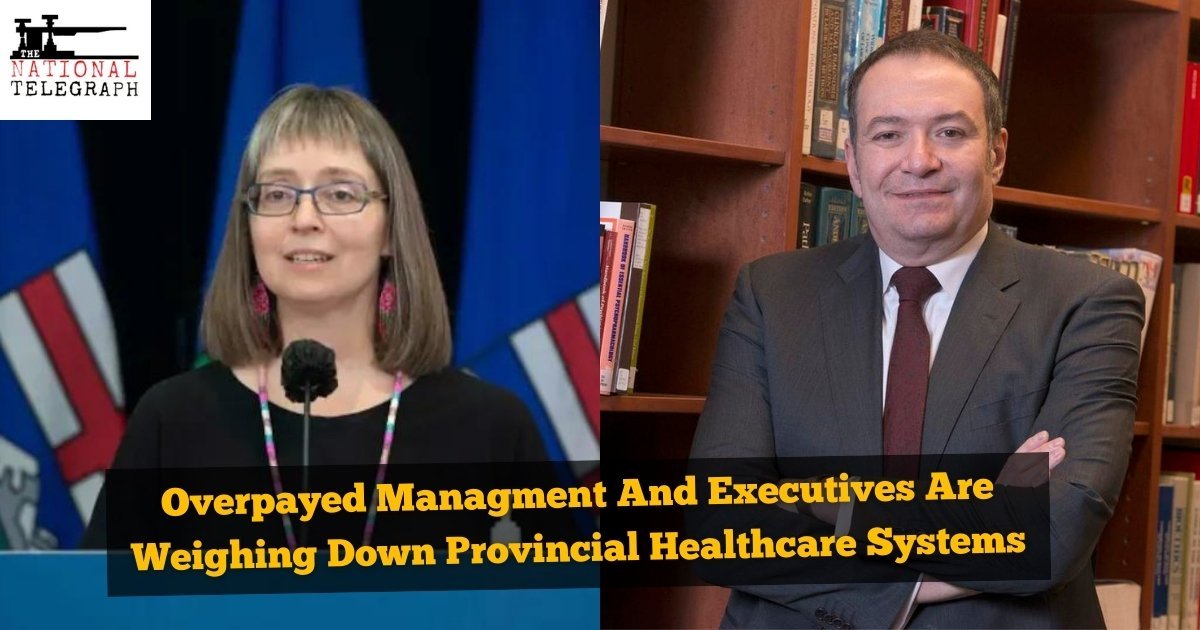Written By Wyatt Claypool, Posted on August 3, 2022

The constant refrain from politicians in Canada is that we need to better fund our provincial healthcare systems in order to fix the inefficiencies. Almost everyone in government measures healthcare quality by the budget of the public system, despite wait times in most provinces trending upwards over time.
It is unlikely that the quality of nurses or doctors fell, and since our healthcare budgets keep going up it is also not like we cannot afford to hire more frontline workers, yet we cannot entice enough medical students to work in Canada.
Clearly, the taxpayer dollars being injected into provincial healthcare systems are buying more resources, but they are also apparently being used to acquire bureaucratic boat anchors. Alberta and Ontario are apt examples to use seeing as they are the two of the wealthiest provinces in the country.
Alberta:
In Alberta, it was just revealed that Chief Medical Officer, Dr. Deena Hinshaw was paid $591,545 in 2021 with $227,911 of it being “cash benefits,” which feels great out of proportion with her role in surveying public healthcare in Alberta and providing the government recommendations.
Dr. Hinshaw never seemed to really be providing her own expertise as her recommendations always seemed to either fall in line with the Alberta government’s political priorities, or the pro-lockdown medical establishment.
Former Alberta Health Service CEO Dr. Verna Yiu, who was fired back in early April (2022), was herself making $573,841 per year, without benefits taken into consideration.
Readers of The National Telegraph should be familiar with Dr. Yiu as we need a long series of articles showing her poor management of ICU beds in Alberta, and that the AHS was manipulating bed statistics, which Dr. Hinshaw admitted was true in January (2022). Dr. Yiu also supported the suspension of unvaccinated nurses and doctors while canceling surgeries for hundreds to thousands of Albertans because of a “shortage” of staff and ICU beds.
Dr. Verna Yiu and Dr. Deena Hinshaw (left to right)
This is not even the half of it seeing as Alberta has over 3,300 people in management at AHS, 900 of which are making more than $132,924 per year.
This is the mountain of managers that Dr. Yiu once described as “very, very lean.”
As of 2021, the average wait time in Alberta for non-emergency services (from GP to specialist treatment) is 32.1 weeks, over triple what it was in 1993,
Ontario:
In Ontario, unsurprising, the bureaucratic nightmare only gets worse, which each subsection of Ontario Health paying exorbitant salaries to bloated management teams of various provincial healthcare programs.
Back in 2019, before healthcare budgets really started getting flooded with new spending, Ontario was paying 1,460 staff in management roles an average of $123,346, at a total cost of more than $187 million per year.
371 staff members working at EHealth Ontario, an agency that creates digital health records for patients, were being paid a total of $45.7 million, and that is only counting those on the sunshine list.
As of 2022, Matt Anderson the CEO of Ontario Health is being paid $826,000 per year, The Ottawa Hospital’s president, Cameron Love, was paid $623,517, and Kevin Smith, who heads up the Toronto’s University Health Network was paid $845,092.
Matt Anderson, CEO of Ontario Health.
These are only a few examples of exorbitant salaries for Ontario healthcare executives, but almost anyone on top or near the top of a healthcare centre in Ontario is being paid at least more than $330,000 plus benefits.
Again, these are the same people who helped suspend or outright fire frontline nurses and doctors who refused to comply with flawed public health mandates, and canceled thousands of people’s surgeries across their provinces, because they were to incompetent to mobilize proper amounts of healthcare resources to handle a surge in hospitalizations.
As of 2021, the average wait time in Ontario for non-emergency services (from GP to specialist treatment) is 18.5 weeks, over double what is was in 1993, and Ontario is technically the best province for healthcare in Canada.
——
It seems like every increase in spending on healthcare in any Canadian province is either taken by the bloated management class or will be hamstrung by terrible decisions made by management or by the government.
Very few decision-makers in Canadian provincial politics seem focused on trying to cut down on the bloat in the management of their healthcare systems and reallocate more money to the actual delivery of care.
The salaries of managers and executives would of course be far less of a problem if they brought experience and wisdom to their roles. but a large portion of them in the various provincial systems seem either unequipped for the positions they hold, or are deliberately expanding the role of management in healthcare in order to justify higher salaries.
No private firm or publicly traded corporation operates this way, and for good reason.
Wyatt is a student at Mount Royal University, where he is the president of its Campus Conservative club. In his writing, he focuses on covering provincial and federal politics, firearms regulation, and the energy sector. Wyatt has also previously written for The Post Millennial.
Very well presented. Every quote was awesome and thanks for sharing the content. Keep sharing and keep motivating others.